

Jacqueline Baidoo - NanoJapan 2015
Xavier University of Louisiana
Major: Chemistry & Chemical Engineering
Class Standing: Sophomore
Anticipated Graduation: May 2018
NanoJapan Research Lab: Profs. Nobuyuki Aoki & Yuichi Ochiai, Chiba University
NanoJapan Research Project: ![]()
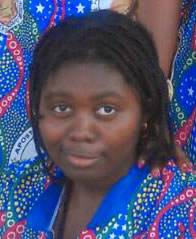
Why NanoJapan?
My high school’s mission statement was to promote lifelong learners, leaders, and global citizens. NanoJapan puts me on track to making that a reality. While I’ve had the good fortune to travel a fair amount, I have never had the opportunity to visit the country I’ve only experienced through anime and manga. I will get to see the world from the perspective of a different culture! This program is important because it expands your worldview and gives you an idea of how research is spread across borders. In the STEM field in particular, knowing how to share your results with other labs means an increased speed and efficiency in whatever subject is being studied. When the world works together, massive studies like the Human Genome Project get completed in no time at all.
I chose to apply to this program for the chance to experience a new culture and learn new research techniques that I hope to be able to apply to what I work on during the semester. Being able to research important questions while completing my undergraduate education motivates me to excel in my classes because it gives me an idea of what I’m working towards. It’s like that bacon-and-treadmill trick: if I can get a taste of my eventual reward every now and then, I know that the work I’m putting in to the future now is not impossible. This summer, I’m most looking forward to trying new dishes and learning the Japanese language.
My goals for this summer are to:
Meaning of NanoJapan: Post-Program
NanoJapan gives students the chance to grow not only as researchers, but also as individuals. It drives home the importance of forming and maintaining international connections by encouraging everyone involved to share information and creating an environment in which language and culture barriers are almost forgotten. Participants benefit from learning more about a problem that may be completely new to them, advisors and mentors benefit from having to explain their research and see it from a different perspective, and everyone benefits from being exposed to a different culture.
Research Project Overview
There were striking similarities between my project this summer and the one I work on during the year. This summer I used three types of scanning probe microscopy to analyze MoS2 for irregularities. The compound is known to exist in at least two phases, one being metallic and the other semiconducting, and my lab imaged samples to characterize which was which and what caused a phase transition. We used atomic force, electrostatic force, and scanning gate microscopy to do so. Respectively, these showed the structure, potential difference, and change in current across the surface of the sample. In my lab at my home university we only use atomic force microscopy to image antimicrobial peptides, so it was a pleasant surprise to learn that there were so many scanning probe techniques out there. We also image MoS2, but it’s with the goal of depositing a single layer via laser deposition. From the experience I’ve found that I enjoy research, but having used the same equipment and even similar materials up till now I intend to explore other problems in research to explore my interests. I know that I’d like a graduate degree, but I’m unsure of what subject I would want it to be in.
The lab I was placed in had a calming environment. Students were left to their own devices and encouraged to focus on school when it conflicted with lab work. My co-workers were welcoming and excited that we were there, and my mentors were helpful in getting me used to both the lab and living in Japan. We often went out to eat together.
Daily Life in Japan
I found day-to-day life in Japan to be very liberating. When I was hungry, I could just pop into a convenience store for a snack because they were on every corner. When I was thirsty, I could get something from a vending machine because they were on every street. When I wanted to go somewhere – anywhere – all I had to do was head to the nearest train station. It was easy to walk around because while there were cars, pedestrians weren’t forgotten. The streets were nice and even and the crosswalks were obviously marked. It didn’t feel dangerous to be outside after dark. I got to feeling empowered, that I could do anything I set my mind to, which was helpful when I was surrounded by things I didn’t fully understand like the language and my research.
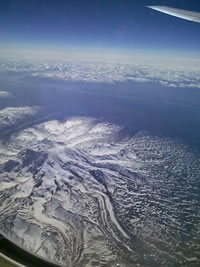
On the Way: How Alaska/Russia looks from 30,000 ft
The streets are clean. The streets are very, very clean, but there are no trash cans in sight. To prepare for this program, I spent the week up until departure studying Japanese culture. No site or guide book I looked at mentioned the fact that if you want to throw something away, you’d better be on the lookout.
Other than that, I would say that my experience so far has been close to what I expected. The konbini is exactly what I wanted and more. Vending machines are everywhere. Bread is delicious. Fruit and vegetables are surprisingly difficult to find. Everyone reads manga. What I didn’t expect was to feel so comfortable after such a short time living here. The day we arrived was overwhelming and stressful and I thought I’d never get acclimated, but just a week later I feel like I can travel, buy food, and even carry on a conversation without too much trouble. The language classes definitely play a huge role in that.
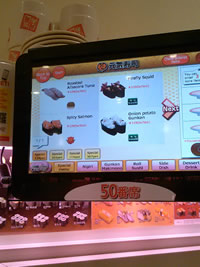
Genki Sushi: Shibuya’s amazing kinda-but-not-really kaitenzushi restaurant. Conveyor belts.
My placement in the language classes is kind of odd: I ended up alone because of my otaku-ness. I arrived with no formal knowledge of Japanese so I couldn’t join the advanced class, but since my love of anime and manga taught me hiragana and katakana I wasn’t quite a beginner either. As a result, I spend three and a half hours alone with an AJALT professor and attempt to hold conversations without awknowledging how awkward it is to spend three and a half hours alone with an AJALT professor fluent in both Japanese and English. While it does feel a bit too intense at times (since all their attention is on me), I enjoy how my professors can answer my questions and correct my terrible grammar as soon as I get it wrong (which is often). The course is pretty much tailored to my learning style, so to cement what I cover during class I practice speaking to cashiers and KIP students.
The day after we arrived, we had an overview of Japanese culture with Packard-sensei. We discussed things we noticed like how almost nobody talks on the streets or in the elevators, and how apologies are used not only to ask for forgiveness, but also to restart relationships. We mentioned HoRenSo – hokoku (report) – renraku (contact) – sodan (consult)– and the importance of the 60th birthday.
On Wednesday we went to see the Nihon Sumo Kyokai Grand Tournament. It was exciting from the very beginning, but I had no idea what was going on until halfway through the first round of matches. The wrestlers were surprisingly flexible and diverse. Not all of them were Japanese, and they were all of different sizes. I found it interesting that there didn’t seem to be any distinction in weight class like there is in boxing and martial arts. Everyone faced everyone, and each match took less than a minute. Some flew by so quickly that if you’d have missed it if you blinked. We got really into the tournament once the championship rounds started, and it was easy to tell who the popular wrestlers were by how much applause they got when they were introduced. I kept my eyes on the people important enough to be sitting on the ground floor by the ring. Unfortunately, I didn’t see anyone toss their cushions at the wrestlers. What I did see, however, was just how many times the players fell onto the people sitting down in front.
We had been told that sumo was a national pastime and not everyone gets the chance to see it in person, but I was surprised to see how many school students came, and how many people trickled in well after the matches had begun. Since things are usually so punctual here, it made me wonder about Japanese culture and when it’s appropriate to be late. Aoki-sensei and other members of the Chiba University lab arrived only a few matches before the end, when the reigning champion Hakuho got to defend his title. Some of the lab members who came (Aoki-sensei included) had to leave before we left for the Sensoji Buddhist temple in Asakusa, but two Chiba students were able to stay to take me and another NanoJapanion out for monjayaki.
Introduction to Nanoscience
Having only taken general physics and math courses and just feeling the effects of waking up at three in the morning, I spent most of the nanoscience lectures fighting exhaustion and confusion. The first lecture by Dr. Stanton covered quantum mechanics and the four important quantum problems like free particles and harmonic oscillators. We went over the band theory of solids and spent some time examining electronic band diagrams and the difference between insulators, semiconductors, and conductors. Ishioka-sensei spoke about ultrafast spectroscopy for materials science, specifically how it applied to her lab research and femtosecond laser ablations. She also spoke about her experience of being a female in science, mentioning the boyish meaning of her name and her birth year as possible influences in her decision. Dr. Stanton’s next lecture expanded on femtosecond laser spectroscopy and explained why femtosecond spectroscopy is so important. Saito-sensei’s lecture was an interactive overview of carbon nanotubes, wherein we covered pentagons (pentagons everywhere!), the Euler Theorem for Polyhedrons, the absolute 110% true fact that you should play soccer if you want to win a Nobel prize, and a quick run-through of Ryuunosuke Akutagawa’s “Spider Thread.”
Initial Research Project Overview
The material I will be using in my research intership is molybdenum sulfide (MoS2). It’s a two-dimensional semiconductor and I’ll be studying its FET (field-effect transistor) transport properties. Molybdenum sulfide can be used in making transistors, which can be applied to the production of circuits whose performance in electronic devices can compete with traditional silicon-based electronics. It can also be used a solid lubricant. Right now I know very little about my research but I hope to understand much more by the end of the summer.
Nagano was a blast. It only took one weekend for most of my goals and aspirations for Japan to be realized. We planted rice, sat in an onsen, partook in a multi-course meal that may or may not have been kaiseki, and were taught a song on taiko drums by the youngest and most skilled senseis I have ever met—and that was just the first day!
Friday morning began with a shinkansen. The seating area was so wide and comfortable that I slept for most of the journey and didn’t get a chance to try any of the eki-ben the attendants were selling. As soon as we arrived at Ueda station, we were met with Isuzu-san, our guide for the weekend. We dropped our luggage off at our wonderful ryokan and visited a Shinto shrine in Aokimura, where we learned the Shinto method of praying (bow twice, clap twice, bow once, clap once) and tried to spot all 8,000 cat statues on the grounds. Next, we visited a farmer’s house to plant rice and have tea. While it was daunting at first to arrive to a camera crew right next to a peaceful farmhouse, it wasn’t long before I got too caught up in the rice planting to notice. It was very systematic, with all us NanoJapanions and the few KIP students who were able to come standing at least a foot away from each other and trying to plant seeds exactly 20 cm apart without the help of a ruler.
After getting to know Aokimura’s frogs and goats, we went back to the ryokan for a bath. Surprisingly, the onsen was only a strange concept for the first ten minutes. After everyone had changed into their yukata, the idea of a shared bath seemed a little less awkward. Once all of the girls had showered and were actually in the onsen, we laughed at ourselves for feeling awkward in the first place. We didn’t get to see Nagano’s famous snow monkeys, but just sitting and relaxing was such an oddly refreshing experience in itself that I didn’t take the loss too seriously. After the onsen we were all treated to a huge dinner of fish, beef, onions, peppers, tempura, manju, tofu, and at least three other foods that I couldn’t name. As night had already fallen, this would have been a reasonable time to end our first day in Nagano, but the most exciting event of the night was yet to come.
My West African roots might be showing, but I really enjoyed the taiko drumming by the Aokimura Gimin Wadaiko group. I can honestly say that taiko was one of the most scintillating experiences of my life…and yet I took no pictures. We were told that they posted a video of our performance on YouTube, but I have yet to find it. Drummers of various ages (ranging from before elementary school to high school) first demonstrated how the drum resembles a beating heart, then taught us how to make that heart beat in rhythm.
On Saturday some of us went to see the Aokimura Insect Museum (in which one of us was likened to a male butterfly), and later we all went to Shinshuu University to discuss the famous cellphone speech given by their university president a few weeks ago and argue whether or not cellphones should be allowed in class. We picked up the rest of the KIP students who were able to come and enjoyed a barbeque with the local villagers. That night, the girls stayed in the ryokan again while the boys got to stay in the wilderness bungalows with Cole’s mixtape as their sole protection.
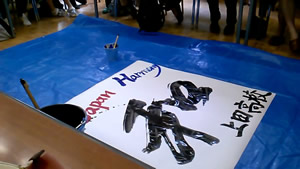
“Wa”: The Japanese kanji for harmony as written (drawn? depicted?) by the Ueda High School calligraphy duo
On Sunday, we visited the three-story tower (a national treasure!), prepared soba noodles, and got to hang out with the English club of Ueda High School. They took us to Ueda castle. While some groups got green tea ice cream and purikura pictures, my group got to meet the Saneda Yukimura (110% true; I’ve got the business card to prove it).
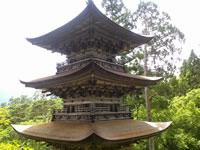
Three Story Tower: A national treasure
By the end of the trip I’m pretty sure we all agreed that Yoshi-san, the KIP student who planned the entire weekend, had really outdone himself with the sheer amazingness of it all. The taiko performance had the greatest impact for me because we got to watch people our age and younger put their heart and soul into every strike. It made me feel welcome, and it was a nice change from the usual politely reserved expression that I’ve grown accustomed to. I’ve noticed that the culture stresses being polite and friendly when the opportunity strikes. This may have contributed to my feeling like a panda in a zoo even though the local villagers at the barbeque either had that polite expression or kept bright smiles. I knew that we’d be treated differently because you don’t see a group of 14 foreign and (maybe) 20 Japanese college students staying in a village on a dail basis. Still, I personally feel uncomfortable being the center of attention so my favorite part of the trip was when everyone’s attention was on something else.
All in all, it was a wonderful trip. Looking through the program schedule ahead of time, I expected to be uncomfortable because I’m a bit of an introvert and find it exhausting to be around a lot of people for a long time. When it came down to it, every program I was worried about went smoothly. I think the Nagano trip cemented the bonds among the NJions (and Packard-sensei and the KIP students). It taught me that you can form deep relationships after just a week of knowing someone, which I hope will teach me to be more open with my labmates once I get to Chiba.
Intro to Nanoscience Seminar
This week’s nanoscience lectures served to provide an overview of the terahertz portion of our research. Tonouchi-sensei began with an introduction to terahertz time domain spectroscopy, wherein he covered what THz is, why it’s useful, and how to generate and detect THz waves in real currents. He shared the wavelengths and timescales of a few types of femtosecond lasers, and stressed how important it was for optical pulses to be in sync in order to gather effective data.
Kono-sensei’s first lecture was akin to stumbling upon an oasis after trekking the Sahara. In the first week, the specificity of the theory-based lectures and my own exhaustion contributed to my understanding very little. This week, I suddenly understood what quantum dots, wires, and wells refer to. Plus, I was excited to use my new fine-point pen. We discussed heterostructures and I learned that MoS2 was one of the first metal dichalcogenides isolated to form a semiconductor, and that its physical properties depend on the number of atomic layers present. Kono-sensei’s second lecture was a bit more difficult to grasp, as I have yet to study the Drude model and the more specific concepts of E&M. We mentioned the difference between intrinsic and extrinsic carriers and the three types of aligned carbon nanotubes (CVD grown, wet span, and vacuum filtration). I enjoyed how Kono-sensei drew experiences from his own lab to talk about each concept as it helped me connect the information to an actual experience. Ishizaka-sensei also mentioned her personal research with polar oxide semiconductors and topological materials before describing how it was to be a female in the field of science. She treated us to pictures of her lab over the years, so we got to see how she gradually acquired students and equipment.
Preparation for Research Internship - Article Review
B. Radisavljevic, A. Radenovic, J. Brivio, V. Giacometti & A. Kis. "Single-layer MoS2 transistors." Nature Nanotechnology 6, 147–150 (2011). DOI: 10.1038/nnano.2010.279.
One of the papers assigned to me discussed the use of single-layer MoS2 transistors in a 2011 research article submitted by B. Radisavljevic et al. Researchers obtained the single layers from applying scotch tape to commercially available molybdenite crystals. The thickness was confirmed using atomic force microscopy. They constructed a monolayer transistor by depositing MoS2 on a SiO2 substrate and surrounded by ALD-deposited HfO2 (chosen for its properties as a gate dielectric and mobility booster). The source electrodes used were composed of gold and chromium. The field-effect transistor fabricated in the experiment was measured to exhibit a room-temperature current on/off ratio exceeding 10^8 and a mobility of approximately 200 cm2/(V*s), which is apparently comparable to that achieved by similar devices constructed of silicon and graphene. While I do not fully understand these results as of yet, I can see the benefit of MoS2-based products that can compete with traditional silicon electronics.
I’ve noticed that people are generally quiet when using public transportation. In order to simplify the getting on and getting of process, it’s common to form orderly lines once the train can be seen arriving and step back to let people disembark before moving forward to get on yourself. Once on, silence prevails. Unless you are heavily inebriated, you speak in either a very quiet voice or not at all. As you might have guessed, this is drastically different from our group. Though we don’t always have things to say, it’s usually obvious where the loud foreigners are once we get on the train (or even before, for the people who were waiting at the station with us). We haven’t completely mastered the art of the “inside you-could-hear-a-pin-drop voice”. I’ve also noticed that, though everyone (young and old) rushes for a seat once it’s free, they also leave their seat just before they arrive at their stops and line up next to the doors so that they can exit as soon as the train stops and the door opens. If you’ve only got one stop to ride, you generally don’t even sit down. Lining up really streamlines the process of riding trains, which reflects the important of harmony in Japanese culture. Come rush hour, however, quite a few things change.
If you’re ever fortunate enough to take a train from 7-8 am or 6-8 pm, you’ve probably experienced a crush of people pressed together so tightly that it’s standing room only and nearly impossible to avoid touching the person next to you. If even one person loses balance, the whole crowd can be pushed into the train doors or the people sitting down. While the basic rules of don’t talk and don’t acknowledge others are usually followed, it’s a fight to get out when you reach your stop. The close quarters can get so uncomfortable that there are women-only cars available.
While I would love to generalize and say that Japanese public transportation is much quieter than in American systems, that wouldn’t be completely true. In American buses and trains people generally keep to themselves. Even in New Orleans streetcars where most of the people onboard (drivers included) are friendly, it’s not like there’s always a conversation going on. In New York and London, trains and buses are also pretty relaxed. It’s also possible that I don’t notice any noise on public transportation because I also keep to myself and tend to tune things out. Still, I do remember riding the subway in New York and having a dance team suddenly break out their routine. I haven’t yet experienced that here.
The differences I’ve observed with transportation are all good ones. There are vending machines everywhere. There are stairs, escalators, and elevators readily available. You can board a train with the swipe of a prepaid card and don’t have to bother with ticket fares and knowing the system. Maps are freely available, in English and Japanese, and if that’s too confusing each line also numbers their stops. For example: you board at N4 and you’re trying to get to N9. Five stops. You can just count the number of stops you make and double-check that number with each station as you pass through.
That said, I’ve never ridden a bus so I couldn’t say if it’s as easy as taking the train. I was told by a friend who visited last summer that, unlike in the States, you pay when you leave, not when you board. I have yet to test that.
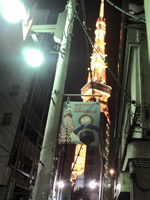
Tokyo Tower and Tokyo Tower as depicted by the he-no-he-no-mo-he-ji scarecrow
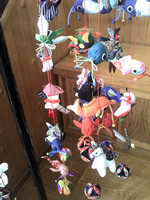
Ryokan Mobile: The wonderful image we encountered upon entering the ryokan
Research Internship Update
Dr. Bird’s first lecture explained much of the basic information behind the theory we touched on in the lectures of the previous weeks. He told us that he’d prepared a more introductory presentation, and it turned out to be exactly that. We were given more information on semiconductor bandgap engineering and the difference between quantum and classical physics. Heterojunctions and growth techniques were touched on before we called it a day. By the end of the lecture, I was wishing that the order of lectures had been flipped. If he had been first, Kono-sensei second, and Dr. Stanton third, I believe that we would’ve had a more gradual understanding of what we would be studying.
Like the trend up until now, Dr. Bird’s second lecture was more complex than his first. We talked mainly about graphene and its impact on nanoelectronics. We learned a few of the physical properties that make graphene such an attractive material, and then we were hit with the reason why it can’t make a good transistor with modern technology. I enjoyed this lecture because while my project isn’t related to graphene, the transistor setup is similar with the source/drain electrodes and back gate. He mentioned the possibility of 3D transistors as opposed to the traditional planar devices. My lab is working with the more common 2D setup, but my project may expand to the 3D system before the summer’s over. I really enjoyed Aoki-sensei’s lecture because it was directly related to my project. He took an hour to describe scanning probe microscopy in depth. Because I’ve used an AFM before as part of my experiments in my US lab, I’m always excited to hear others explain the theory behind it, and as I’ll be using SGM and EFM techniques it was helpful to hear about them from the person in charge of my lab.
I like to think that our first day at the lab went well in that it actually started a day before. One of my mentors met us at the train station, showed us around our dormitory, then accompanied us to the supermarket to give us the chance to have lunch and buy anything we thought we’d need. Before he left us to ourselves, we agreed on a time when he would meet us in front of our dormitory to show us to the lab. We figured we could spend the rest of the day exploring the area and call it a day, but it didn’t turn out the way we planned.
After walking around and being lost for about half an hour, it became apparent that our dorm was in a residential area, meaning that the streets were generally empty and the majority of the shops and restaurants available were by the station. We took the train to the next station to look for things to do and happened upon the university. Once we arrived, we saw my mentor with a few others from the lab. Though at first they were surprised to see us, they took us to the lab and let us see the environment. When we were ready to leave, we were told to meet at the lab the next morning instead of at our dorm. While this meant we’d have to leave our rooms earlier, it made me feel like we’d shown ourselves to be more responsible than they’d expected. When we did arrive at the lab the next day, people were friendly but not intrusive. I wasn’t sure if they had been looking forward to our visit until later in the day when we noticed what was written on a whiteboard in the lab. We pieced together “NanoJapan” in katakana, a date, and rows of kanji next to circles or question marks and deduced that they were the names of who could attend our welcome party later that week.
I actually have two mentors in the lab. The one who showed us around on Sunday was Matsunaga-san, a PhD student, and the other is Higuchi-san, a Master’s student who arrived in March. Matsunaga-san is super comfortable to be around. He exudes a sort of confidence in whatever he does but he’s still really playful. He speaks English really well but he usually pretends he can’t. Higuchi-san lives in Tokyo so she wasn’t able to meet us on Sunday (even though Matsunaga-san lives in the same town, we’ve never crossed paths outside of the chance encounter at the university). Higuchi-san is the only girl in the lab out of about fifteen people, and she’s really happy to have us here. She doesn’t speak much English but she understands more than she has confidence in revealing. She found an app that lets you speak in either Japanese or English and have it translated, so we’ve been using that.
Everyone else in the lab is kind and willing to help if you have a question, but we haven’t had the chance to talk much because I generally don’t know enough to think of questions, and when I do it’s in a mixture of broken Japanese and English that must be hard to understand. I consider the first week to be a success because we’ve kind of established an I’ll-speak-your-language-you-speak-mine kind of relationship, which is wonderful when you’ve got something to talk about. For me this is kind of a big factor, as most of us seem to be the kind of people who don’t speak unless there’s a reason and while that works when you’ve got months with someone, it doesn’t help when you’ve only got eight weeks together. The language of choice is Japanese, but I don’t think this will have much of an effect on how well my work goes. It’s surprising just how much can be communicated through gestures, pointing, and the internet.
Our housing is really convenient. Upon arrival I found courtesy sheets, trash bags, toilet paper, and a small bean pillow. There’s a mini fridge, a mini kitchen (sink, stove), an air conditioner, and a small bathroom with a toilet and shower. There’s Wi-Fi, but only my computer can find it. My Android phone can pick up the Wi-Fi from next door, a floor above and below, and even the next building sometimes, but for some reason it can’t locate the router that’s two feet away. At the lab there’s only a wired connection, so there are some updates and messages that I won’t be able to receive until I get to a train station and figure out the JR Wi-Fi situation. In the States my college’s Wi-Fi isn’t too reliable, but I can switch to mobile data whenever necessary. I haven’t been too disadvantaged by the lack of data, but it would be something I’d consider for the next time I travel.
Because our dorm is literally one station over from our lab, there isn’t much of a rush to get going. It’s a twelve-minute commute if we hurry, and maybe twenty to twenty-five if we go really take our time. We have yet to try walking to the lab because it’s usually pretty hot in the mornings and we’d need to set out early to account for the very real possibility of getting lost, but I definitely want to try it, especially since going back and forth by train is getting to be expensive. Aoki-sensei told us that once we get our student ID cards we’d be able to get a discounted fare, so I’m looking forward to that. At nighttime, the area is dimly lit and empty in a way that makes me feel less safe at eight in the evening here than I felt at one in the morning in Tokyo.
Assessment of Orientation Program and Language Classes
Hands down, taiko was my favorite experience. We got to do it twice, and both times were amazing. The first night in Nagano we learned a two-person song from several young senseis in a dojo type of setting, and once we got back to Tokyo we got the opportunity to learn a solo from a taiko master in a practice studio. After taiko, I enjoyed the rest of the cultural outings pretty equally. Sumo, rice planting, and the onsen helped me grow acclimated because the time in-between each planned event ended up being just as important to me as the main event itself. I hadn’t, for example, expected to have tea before planting rice and making the Shinkansen to Nagano was an adventure in itself. The lectures were varied and interesting. I enjoyed how we could go from a casual cultural lesson with Packard-sensei to a challenging science lecture with visiting professors to a relaxed discussion about Japanese politics in the span of a few days.
The language classes were interesting. Over the years I’ve picked up words and phrases from anime and manga, and by the time the program started I had started learning kanji, so I ended up being in a beginner’s class by myself. Because of that, I think the structure was a little different. I had very little knowledge of grammar and necessary phrases, so I learned the same material as the other beginner’s classes and was given the same homework, only the use of kana was stressed from the get-go, I was given kanji worksheets, and every so often I would get to read a children’s story. By the third week I was starting to feel fatigued by all of the work, but I enjoyed it. For me, the only negative aspects of the lessons was that they were one-one-one. While I really dislike being the center of attention, I also prefer being in a group because it fosters friendship. I learned a lot from and about my senseis and got close with them, but I felt like I was missing out on a chance to learn about the people I’d be with for three weeks. Still, I noticed that each group moved at a different pace so I’m grateful for the opportunity to set my own pace and not be rushed or slowed down by others. My goal for this summer is to be able to hold a conversation in Japanese with as few mou ichido onegaishimasu’s as possible.
Overall, I found the orientation program to be helpful. There was a lot of information in the first few weeks, too much to be expected to recall everything, but I’ve been able to retain a fair amount. For me, the best part was getting three weeks to adjust. If we had gone to our labs immediately after arriving, I would have been overwhelmed and terrified of making mistakes. This way, I got the chance to get used to the culture and environment while building a network of people I could talk to when I got too frustrated.
I think that the most important thing that I know now that I didn’t know before arriving in Japan is how considerate people can be. It’s most apparent in stores and konbinis: when you get a bento and forget to ask for chopsticks but find that the clerk already put one in your bag. When you realize that the reason it’s so easy to carry your PokéCenter goods around is because the clerk taped the top of the bag shut for you. I’ve seen people chase down strangers to return something that was dropped several feet away. I’ve had people go out of their way (elevators-and-stairs out of their way) to make sure I get to my destination when I’m lost. I only knew to expect politeness, and courtesy is very different from compassion. The level of compassion here is over nine thousand.
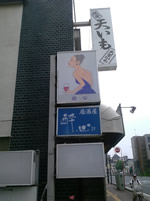
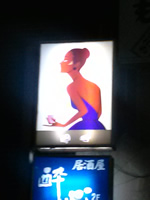
Day 'N Nite: One way by day.. and by nite
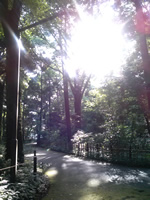
Meiji Shrine: Or Yoyogi Park. I was this close and had no idea.
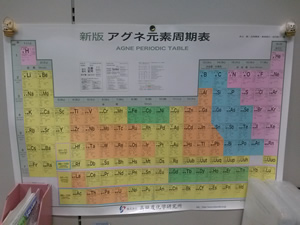
Only About Twenty Matter: In Orgo.
NanoJapan Research Project Update
Research Project Overview
Molybdenum disulfide (MoS2) is a semiconducting material with electrical properties that vary depending on the number of layers present. Currently, there’s been a lot of research towards how well it performs as a transistor with the hope that eventually it can replace silicon. My project deals with imaging and analyzing the field effect transistor (FET) transport properties of MoS2. I am not sure what kind of results we’re expecting.
Research Methods
The MoS2 samples that we will be using are fabricated by students in Dr. Bird’s lab and sent for us to image on the AFM/EFM. I get the impression that I’ll only be working with the AFM and the various electrical equipment to take pictures of the sample and it’ll be up to someone else (probably my mentors) to analyze it.
Training
I definitely need to study the theory behind electrostatic force and scanning gate microscopy and the background behind the material I’ll be using (such as what techniques were used to fabricate the samples and what makes one sample different from another). I’m accustomed to the theory behind atomic force microscopy because I use it often in my American lab. Even though the microscope is a different model and the program is an unfamiliar software, it’s reassuring to have something that I have experience with.
Timeline
Tomorrow I’ll start learning how to use the SGM. My samples should arrive sometime in the next week, and by then I should be able to scan them myself. Until then I’m still learning how to run the machine and record data. I hope to have a few images by the time the Mid-Program meeting rolls around but I have yet to talk about the logistics of my project beyond that.
The Saturday before everyone went off to their respective research labs, a group of us visited Kamakura. We spent the day visiting temples, shrines, and the majestic Daibutsu. For me, at least, getting there was just as interesting as being there. I had only used the JR once, for the Nagano Shinkansen, but the regular JR lines are different from both the Shinkansen and the Tokyo Metro. They share a layout (seats along the edges, plenty of handholds) with the Tokyo Metro subway trains, but they tend to run aboveground. The Shinkansen also ran aboveground, but its layout was more like a roomy airplane.
Kamakura was a day of many firsts for me. It was my first time traveling for longer than an hour for a day trip, eating shirasu, and seeing a giant Buddha statue. It was also one of the few times that I remembered to take pictures. Seeing so many foreign and local tourists toting cameras inspired me to take a few pictures of my own. In the very first temple we entered there was a detailed statue that gave off a majestic air. I took a picture of it.
I got my first hint that something was wrong when I looked up and saw everyone staring at me. Thankfully, I was only facing familiar faces (KIP and NanoJapan students) so it wasn’t as intimidating as it could have been. I was told that it’s not proper to take pictures of holy images, as it’s believed to capture their spirit and detract from the whole. When I looked down at the picture on my phone, I completely understood. The statue appeared to be glaring at me with all the ferocity of the original, so I deleted the picture and sheepishly left the temple. Other than the obvious cultural infraction, I was also disappointed in myself. I found it somehow ironic that I had been insensitive enough to take a picture of something that didn’t like pictures.
Overall, it was an experience that I learned from. The result was that I now know not to take pictures of religious statues. Intention-wise, I can only analyze it from my own perspective: I took the picture because I wanted a memento of Kamakura. The other students might have spoken up to educate me, to keep me from embarrassing myself, to keep me from embarrassing the others, or maybe all three. I can’t pretend to know their reasons; I can only appreciate the fact that they told me. The experience effected the way I view taking pictures as memorabilia. Now I try to think of the consequences of taking a picture and weigh the pros and cons of having one, whereas before I would just avoid taking pictures because I didn't want to be bothered.
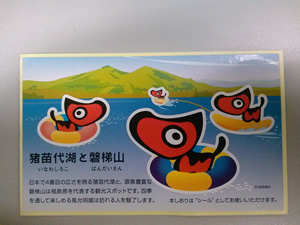
Akabeko Red Cow: That kind of looks like a dog
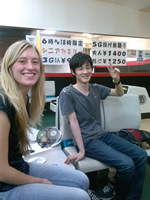
Bowling: Totemo tanoshikatta desu.
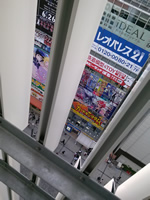
Akihiabara: From ten stories up
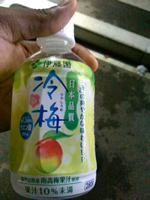
Oishi: Well worth 130 yen
NanoJapan Research Project Update
Something I’ve noticed is that as we progress from SPM to SPM, the scanning time and number of machines used increase. With just the AFM, there’s only one scan and pictures take anywhere from ten to forty minutes, depending on the scan speed that you set. With the EFM, there are two scans: the first is the regular AFM topography scan with no bias voltage at the tip, and the second is the EFM conductivity scan with a voltage running through the tip. We use an oscilloscope in addition to the computer and the AFM controls. With the scan speed we use, these pictures usually take thirty minutes. The other day, we used the SGM to analyze a sample. We turned on no less than three machines that I hadn’t seen used up till then, and each picture took an hour. The process of setting up pictures build on each other and have been thoroughly explained to me, but I have yet to try it for myself. I think my mentor is picking up on this, as he asked me to set up the AFM side of things when we were preparing to take SGM pictures. I kind of panicked and ended up just telling my other mentor what I thought should be done, and then she did it for me. It’s been implied that once my samples arrive I’ll be in charge of scanning them, but there are four people in my team: my mentors Matsunaga-san and Higuchi-san, and a fourth-year undergraduate student Yamanaka-san. While Higuchi-san does most of the scanning, she’s still learning what to do when you run into a problem. I haven’t seen Yamanaka-san load and scan a sample by himself, so I’m not yet sure if we’ll all do the next batch of samples together or if it’ll just be left up to me, or some combination of me and the other three.
NanoJapan Tip: Try taking photos of each step of the process and then making detailed notes in your lab notebook. Then, you can put that all into a word document that you can print off or look at on your computer when its time for you to start turning on all the machines and loading a sample by yourself.
This week made a point of how far we’ve come in studying Japanese. I don’t think either of us really noticed it until one dinner with Packard-sensei and the other NJions, but since then I’ve realized there have been several instances where we’ve used it successfully.
At a dinner with Packard-sensei and other NJ students one night, we spoke in a mixture of Japanese and English (maybe 90 percent English, 10 percent Japanese) and we were understood. When we made plans to meet at a lesser known station and I foolishly walked fifteen minutes off in a direction first around, then in a direction I hoped would take me back to the station, I asked a woman on the street if she knew where the station was. She told me I had come to a completely different station, walked me there, then explained my situation to the train station staff before we said our goodbyes. All in Japanese. On a recent trip to Disneyland we watched a Lilo & Stitch performance about the Big Kahuna, and then saw a Once Upon a Time special projected on the iconic castle. All in Japanese.
From experiences like these, I think our biggest achievement is being able to communicate with others. Whether we understand every little word or not, we usually get the message and can reciprocate. As we get closer to our labmates and they to us, we have more and more instances where we’re on the exact same page no matter how confusing the Japlish. This is why I don’t consider the language barrier to be the biggest challenge of my time in Japan.
In my opinion, the biggest challenge is asking for help. This is a personal goal of mine because I’m the type of person who would seriously consider spending hours lost before making the decision to get over conflicting feelings (caused by inconveniencing others, admitting ignorance and/or weakness, and talking to people in general). It’s been getting better: I asked for directions that one time and have been working on asking the purpose of the various parts of my research as soon as something’s unclear. Even with these wins, just yesterday I found myself taking two hours to look for a PokéCenter after declining the aid of a stranger who noticed my confusion and offered help. I didn’t find it before I had to leave. I still have some work to do. Ganbarimasu.
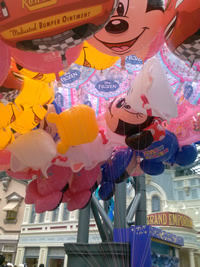
Balloons: Majestic balloons at the happiest place on earth
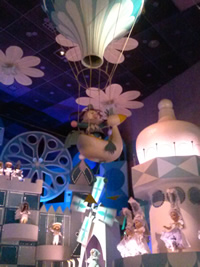
Frozen: Because it’s a small world after all.
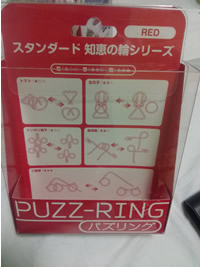
Puzzle Rings: Also known as chienowa. Super-cool
Research Project Update
As far as research goes, I’ve been watching my group scan samples. The other day I received a more in-depth explanation on the background of the research and I’ve been asking questions every now and then to improve my understanding. The samples that I’m supposed to work with have just arrived. Because the hypothesis we’re working toward is more of a question of analysis, the samples we’re working with now and the ones we will be scanning fulfill the same purpose; they serve to defend whatever conclusion we arrive at. Since we’re looking for the reason behind a certain phenomenon, having more data can only help. The difference between my samples and the ones we’ve been scanning is that the ones that metal has yet to be deposited on the samples that just came in.
Quite a lot of the language has been learned. Before arriving, I knew nothing about grammar, verbs, and the most basic words. I was only familiar with oddly specific words that are frequently repeated in anime and manga, like glasses and noisy. I had no confidence in constructing actual sentences. Orientation gave me a basis for conversation. If I was to give it an age, I would say I went into orientation with the vocabulary of a one year old and left with that of a three year old. I understood basic conversations and started picking up on the different ways that people say the same thing. I think I improved once I got to my lab and started to hear the language regularly because I’ve been able to practice listening for distinct words at all sorts of talking speeds and volumes. Listening has probably been most helpful in my learning the language.
The best example I can think of is numbers. In the language classes we were told to say the amount we were giving to the cashier, and then “onegaishimasu.” We also dedicated one Friday to numbers and the different ways we might hear them (fractions, decimals, percents…). Even with this, I would always freeze when I went to pay for things. I couldn’t think of the Japanese words quickly enough and ended up stumbling through whatever I was trying to say. The effort usually made me flustered enough to miscount and give the wrong amount, anyway. Just the other day, however, I found myself properly counting and announcing the number. I didn’t realize how smoothly it had gone until after I had done it.
After the three weeks in Tokyo, we started taking language classes at Chiba University. There was only one class available, so we were just placed in one of the lowest levels. It was a little surprising that the very first lecture we sat in on (halfway through the semester) covered the exact same words we had covered in Tokyo. Save for a few research- and university-specific words, the language classes here turned out to be the same as the orientation.
I can’t think of any particularly challenging miscommunications because the people I speak with are usually patient enough to resolve any misunderstandings. I’ve also noticed that people make more of an effort to get their message across when there’s a language barrier. Because it’s universal, it’s almost inevitable that body language is used in conversation. There was an interesting misunderstanding that occurred during the mid-program meeting: a few NJions went kayaking. There were eight of us total, and we all chose to rent two-person kayaks. Before each group went out, we were fitted with life jackets and given detailed instructions on where we could and couldn’t go. These were verbal, but there were lot of gestures. My partner and I were the second group to set off, and after we set off we realized that we both understood what had been said pretty well, even without the gestures. This was why we were so surprised when we witnessed the first group to set off do exactly what we’d been told not to do. Pretty soon, one of the beach staff came roaring out on jet ski to reign them back in, and we started warning the two groups behind us of what we’d heard on the shore. I found it interesting not only because it was pretty funny at the time, but it also because it brought attention to how flawed my thought process is. I tend to assume that everyone knows what I know and I know nothing of what everyone else knows, but that way of thinking doesn’t work past age five. It’s an aspect that I need to work on improving now that it’s become apparent.
One effective technique I’ve noticed is to be inquisitive. If you point at something and ask what it is, you’ll usually get an answer. Often the answer is in Japanese first, which only helps because then you can write it down, check the spelling, and look it up later. If I get an answer in English, I have to work a little harder to remember if I don’t write it down. I’ve been learning kanji online, which helps me not be overwhelmed by the signage I see daily. I try to read manga, specifically shoujo or series directed to children because they’re usually about simple things and general life. Plus, if it’s not all in hiragana there’s always furigana to help you read the kanji. Still, I think that the most effective technique is to keep your ears open. While it can be frustrating to sit through hours of a language you’re unfamiliar with, it’s necessary time when you’re trying to learn how to speak it. I’m kind of used to the feeling because I get it pretty often at home.
My experience in Japan has made me eager to learn more about the language. The sporadic months of self-study that I’d done before arriving was meager at best, so coming here and seeing how much I don’t know inspires me to work harder. For the past two months I’ve been immersed in Japanese and English and have hardly explored the other languages I’ve been studying, so I’m worried that this is only a temporary motivation. While I would love to take formal language classes in the States to keep me motivated, my university doesn’t offer any Japanese courses. I’m also worried that because it’s been self-study for so long, there’d be a radical difference of knowledge throughout a semester: I might go weeks not cracking the book open because it’s material I’ve already learned, then spend hours cramming for concepts entirely new to me that other students were gradually broken into. For now, self-study is my method of choice. It should be different this time around because now I have textbooks and reading material to put to good use.
What I took from the Mid-Program Meeting was the feeling that I’m not trying hard enough and should work harder. The other NJions had a lot to say about their respective projects, and (even though this may be tied to my lack of presentation skills) they seemed confident that they knew what they were doing or would know in the next few weeks. It makes me eager to do the same. Aside from the research part of things, it was nice to see everyone again and hear what they’ve been doing. When we first arrived in Japan fourteen people seemed like a huge group, but in Okinawa we seemed small. I think it has to do with how distant we were from each other in the beginning and how close we are now. Also, シーサー。Lots of shiisaa.
That said, the Okinawa Institute of Science & Technology Graduate University is really a school of the future. The light switches are panels on the wall. The brightness and height of the window blinds are controlled by a single panel on the wall. First year students are put on a lab rotation and everyone has access to dozens of common-use equipment. Computer systems are replaced every three to four years. The MTSA conference put us in a position to experience some of the advantages of being at OIST, and the tours had more than a few of us considering OIST for graduate school. Even with all the state-of-the-art technology, it isn’t hard to believe that it used to be a zoo when you see the vibrant greenery and clear ponds. It was designed to put Japanese graduate students in an environment where English is the language of choice, so everyone we met there was fluent in English regardless of where they originated from. There are no departments, only lab units, which encourages cross-disciplinary research, and the fact that the school is growing at an amazing rate is proof of its success. Over the course of our visit we were informed of several buildings and units that didn’t exist last year.
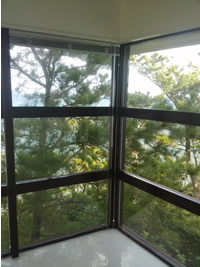
Seaside View: Only one small piece of the amazingness that is the Seaside House
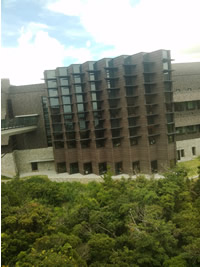
OIST: One of many labs at Okinawa Kagaku Gijutsu Daigakuin Daigaku
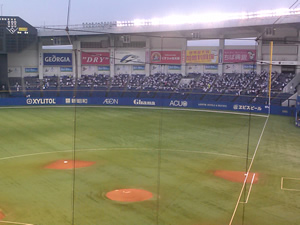
Marines vs Fighters: Ghana choco!
Research Update
After getting back from the conference, we’ve started scanning my samples. There are quite a few of them, and they’ll take longer to scan than we’ve accounted for. I hope this will give me the chance to learn how to operate the actual AFM instead of just the program because it would be useful to know how to maneuver the microscope by myself. One of my mentors lives one station away, but is super busy with the other things going on in the lab, while my other mentor has fewer responsibilities but lives an hour and a half away. This is my only responsibility and I live less than half an hour away, so I think the best arrangement would be to have me learn how to operate it on my own so I can spend the late nights scanning. I have high hopes for this because I’ve noticed similarities between the AFM we use here and the one we use at my university, and I’m often entrusted with scanning pictures with that one after everyone else has gone home.
It feels strange to compare labs in the US and labs in Japan when I’ve only experienced one lab environment in either country, and each has put me in strange circumstances. Because my home university doesn’t offer a graduate program in sciences, I’ve had the opportunity to work with equipment like the atomic force microscopy (AFM) and hold meetings with my mentor about research goals. Because NanoJapan arranges for undergraduates to conduct research at renowned labs under graduate student mentors, I’ve had the opportunity to explore other types of scanning probe microscopy (SPM) techniques and be completely confused about where I fit in along the lab hierarchy.
The biggest cultural difference I’ve noticed is the different ways that people communicate, specifically how they call each other. People usually use the honorific “san” to refer to people above them, unless it’s to us. I’m not sure if it’s because they feel distant from us, want to show extra respect, or are just following our lead because Kato-san and I really do call each other by “san” all the time. The fourth-year undergraduate students in our lab use it for everyone who isn’t a “sensei” or also a fourth-year. They usually call each other by their last names without honorifics, or nicknames (Tomochin for Tomoki, Uesama for Uenoyama). Nicknames are popular with the graduate students when referring to fourth-years. Higuchi-san calls the other first year Master’s students by “kun,” and Aoki-sensei and Ochiai-sensei add “kun” to everyone’s last name. In my lab in the States there are nicknames and such, but my mentor is usually “Dr.” and everyone else goes by their first name. This isn’t too surprising because from the Orientation, my alumni mentor, and general research on the culture, I got the idea that hierarchy would play a role in things. I wasn’t expecting to be confused as to where I stand within it.
I’m at the bottom. As a second-going-on-third year undergraduate student, I rank below everyone in years, education, and experience. Still, I’m encouraged to ask questions to my sensei and mentors, and am asked, every now and then, to give my opinion. Because I’m not sure how transient “visiting researcher” is in relation to everyone else, I’m left feeling confused about whether it would be rude to interrupt my mentor when he seems busy or ask Aoki-sensei a quick question when my mentors have told me he could answer it in the most detail.
Value-wise, I think both labs note the importance of getting your work done and participating in lab activities like weekly meetings. Exceptions are made now and again, but the general idea is that research can’t be done without a collaborative team effort.
The ability to take part in research has encouraged me to be a more active listener in academic classes and work on improving skills I lack. It’s helps me understand how things fit together. I am very thankful to have been able to start research as an undergraduate student, while I’m still considering my future and figuring out what’s best for me. In this lab, it seems that students take classes up until third year, when they start thinking of labs to apply to, then spend their fourth year getting started on research and preparing for the Master’s student entrance exam. I prefer my experience in the US because it pairs research with classes.
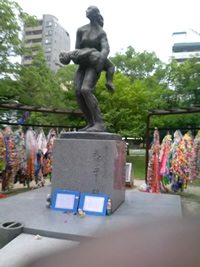
Hiroshima Peace Memorial Park: Thousand Paper Cranes

Atomic Bomb Dome in Hiroshima
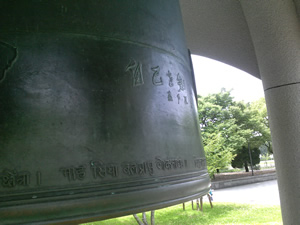
Bell of Peace in Hiroshima: Engraved with a map of the world
Research Update
My project has to do with characterizing different structures present in monolayer MoS2, 2H and 1T. 2H behaves like a direct bandgap semiconductor, while 1T behaves like a metal. If both are present within the same MoS2 triangle, the point at which they connect is known as a Schottky barrier, identifiable by a sharp increase or decrease in charge carriers. Past samples have been MoS2 triangles with source and drain electrodes deposited by electron beam lithography. Measurements of those samples showed regions of distinctly different surface potentials, with “bright” regions consistently appearing next to the electrodes, and “dark” regions being in the center of the triangle, furthest from the electrodes. Such a contrast in electrostatic force brought up the possibility of one color representing 2H and the other 1T MoS2. To see if the electron beam (EB) irradiation caused by the lithography was at fault for the color change, we received new samples where the process for lithography was followed saved for the final metal deposition. This effectively meant that half the triangle had been exposed to EB irradiation, while the other half had not been. We saw some interesting results that we’re still trying to make sense of.
While the EFM images showed three major types of images, the AFM consistently showed a distinction between the exposed and unexposed areas. The unexposed region was always a brighter color, meaning that it was physically higher than the exposed region. This indicated that even after removal, there was residue left over from the resist that stuck to the AFM tip.
One thing that came as a surprise to me was that everyone in the lab has the same major: nanoscience. Another surprise is how everyone is pursuing at least a master’s degree. Classes end and research begins in the fourth year of undergrad. There are still lectures to attend, at least at Chiba University, but from what I’ve seen most of their time is spent doing research and studying for the master’s entrance examination. It’s typical for fourth years to pursue higher degrees in the same university, but in the case of one of my mentors her professor was a graduate of Chiba University and recommended her to Aoki-sensei’s lab. It also seems like it’s rare for people to choose to go on to a PhD course, because there’s currently only one PhD candidate out of the fifteen students in the lab.
Just as one would expect from a lab, the work environment is lax in some ways and strict in others. At my lab, at least, coming in at ten in the morning is early. People start arriving at ten thirty, but it’s not strange to come after noon, especially if you live an hour and a half away and spend the night before working till midnight. It’s flexible. That’s a big difference between this lab and the one back at my university. There, you agree to come in either at eight or nine in the morning and stay till four or five in the evening. We rarely work past six.
Here, there are set groups and weekly meetings. Teams of graduate and undergraduate students are given a topic to research and it’s up to them to present some form of data to the sensei and the rest of the lab by that Friday’s meeting. In my other lab we have sporadic meetings, and when we do have them only one person presents and everyone else just says what they’ve achieved so far. Like here, my professor assigns people to projects, yet he’s also open to requests.
Something that both labs have in common is how they’re not particularly international, not in the sense that they’re studying in a country different from the one in which they were raised. Here, the only non-Japanese student is a PhD student from Sudan (who technically isn’t a student of Chiba University anymore since he graduated two years ago). There, everyone is American and so is a mixture of several cultures. There are a few people with direct ties to different regions of the world like Palestine, DRC, and Nepal, but most of us were raised in the States. That’s not uncommon in the States, but here it’s cause for wonder. There are few foreigners at Chiba University in general, and even fewer studying science. Knowing English is highly valued here; it’s used at international conferences and in all of the research papers we read for our projects. For this reason, master’s students have weekly presentations where they explain the theory behind and results of research papers. It’s made me realize just how much English is used worldwide. The internationalization of research has come to mean that it’s the type of language you can use and almost always be at least partially understood. This has made me feel lucky for being born into an environment where I grew up using it. It’s also made me eager to learn enough of other languages to at least meet people halfway; being spoken to in your mother tongue gives a completely different feeling than being spoken to in a language you understand.
Career-wise, it seems that more people get master’s than doctorate degrees. I think it’s the same in the U.S., but seeing as how a large part of the master’s coursework for sciences here has to do with listening to lectures in English, I would assume that linguistically pursuing a degree here is more difficult. It’s a little unfair and makes me think of how the pursuit of foreign languages is also required in American middle and high schools yet few students actually learn from it. Imagine if every U.S. graduate student was required to have a working knowledge of French before receiving their degree.
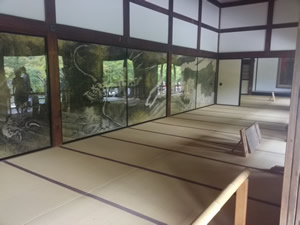
Tenryuuji Dragon: Beautiful temple near the bamboo groves
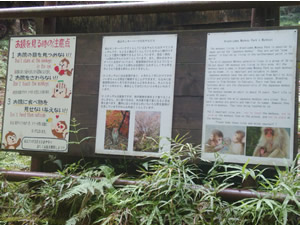
Arashiyama Monkey Park Rules: First, second, and third of which: do NOT feed the monkeys
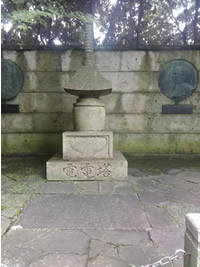
Last Place…I expected to see Thomas Edison
Research Update
This past week we scanned new samples, M03, that were more like the samples from before. They had electrical contacts made using electron beam lithography. Unlike before, the EFM images didn’t show distinct regions. This might be because the sample wasn’t grounded before we started scanning, so this week we’ll be redoing the EFM scans along with SGM scanning. It’ll be difficult to get much done before Friday because we already lost Monday to the office holiday, and another group is scheduled to use the AFM this week. We technically only have Thursday to work on the samples before some lab members (my mentor included) leaves next week for a conference in Sendai.
Last summer I stumbled upon Haruko Obokata’s story, when the initial excitement had already begun to decline and her supervisor had already made his decision. I remember being shocked at how much her gender was brought into things. She wasn’t just a young researcher caught up in the struggle for recognition, but she was a deacon. A role model for Japanese women everywhere, not just those in the science field. Her every action was put under scrutiny under the tagline that this is the modern Japanese woman. Now, she’s a martyr. When other researchers and co-authors were unable to replicate the results, fingers were pointed. Again, it was only her name being spoken freely. I was slightly surprised to hear that there were authors other than Obokata. It seemed as if all the pressure was placed on one person’s shoulders, and yet that probably isn’t true.
It’s my belief that the concept of STAP, or stimulus-triggered acquisition of pluripotency, cells are a wonderful contribution to science. If I understand correctly, stem cells are considered to be a kind of blank slate. There are various kinds with different characteristics, yet the trait that I find the most interesting is how there exists a type of cell that can grow to become whatever it’s surrounded by. One of the many issues preventing their widespread use is the matter of how to obtain them. Ethics prevents us from gathering them when they’re being formed at the beginning of life; harvesting umbilical cords and fetuses for stem cells is not a popular idea. Another option is to take them near the end (or middle) of life, to somehow revert to its undifferentiated state, to take a mature muscle cell (say, from the triceps) and tell it to rethink its entire being and join the lung cells, essentially changing its DNA. Whether STAP cells can ever be reproduced or not, the possibility that this process could be done in the relatively simple way suggested by the group at RIKEN labs is mind-blowing. That’s one legitimate reason for the excitement surrounding their discovery.
That said, I’m sure everyone who took part in the controversial research is going through their own troubles. The attention from the media isn’t everything. She can’t be the only one suffering when it’s likely that a majority of (if not all) of the group of co-authors whole-heartedly believed in the results and must be feeling horribly disappointed and betrayed by the turn of events. There also must be those feeling ashamed for having something they contributed to turn out so poorly. There are various ways to handle these feelings, and I have no right to judge people for their reactions, be they the researchers in question, the media, the public, or others in the scientific community. I have no right to judge, but I am entitled to take offense to how it seems that the matter at hand was not stresses enough, and rather the focus was put on one person to represent an entire sex.
That was my reaction to the events. Having the opportunity to live here for an extended period of time has taught me to not be surprised. I haven’t personally experienced such pronounced distinction. My lab shares an area with at least one other lab, and I have seen two females use the space out of five or six males. I consider that to be a good ratio. I never see my mentor being outright discriminated against for her gender (which isn’t to say it doesn’t happen, just that I don’t notice it). What I have seen is the hierarchy at play, and so I can slightly understand the feelings of the people above Obokata since the mindset I’ve observed is that because the top of the hierarchy is in charge of keeping everyone else in check, they’re also greatly affected by any good or bad news. In my lab at least, everyone reports to the sensei and if they’re treated any differently it’s more to do with their own personality than anything.
Outside of science, I’ve noticed a standard style among girls (at least college-age): cute. While the university students here are generally better dressed than their counterparts at my school and everyone has their own traits, girls tend to wear lots of frills and high heels and lacy socks. They tend to speak in cute, high-pitched voices and have cute habits, but this doesn’t stop them from taking part in activities you wouldn’t think of as feminine, such as hiking mountains and running for the train (which everyone does regardless of how well-dressed they are). While I’ve noticed very little about how girls are treated, I’ve observed even less about boys. All I can recall is that if I suddenly hear loud voices, more often than not it’s a group of boys than girls. Since Japan is a quiet country, it could be that boys are more easily forgiven for societal transgressions, just like their U.S. counterparts (“boys will be boys”).
Fortunately (or unfortunately, for experience’s sake), I have not personally experienced gender discrimination in the US. I was raised to believe that males and females were academically equal, and growing up I doubt that any of my teachers tried to instill anything to the contrary. In university, too, I’m in a special situation: my school doesn’t have an engineering school, so I’m currently in a 3+2 dual degree engineering program where we transfer after three years. Females are already the majority at my school, and this combats the lack of girls in engineering classes that I hear about at other schools such that there’s more or less an equal number of girls as boys. Because the class sizes are so small, discrimination based on gender would harm more than help anyone so inclined. This summer I’ve been able to hear from other NJions about their schools and how they’re treated. While it’s become a large part of why I value this experience in Japan, it’s also made me wary about the environment I should expect at engineering school. I hope to steer clear of the type of people who, like the media during the heat of the STAP cell scandal, are more than willing to put my gender before my achievements. I need to think carefully about which schools I’ll be applying to.
Research Update
This week I worked on my poster. The most difficult part was deciding which results to display. My abstract talks about various methods, but I can only explain so much about what I’m doing so I’m reluctant to include the more difficult concepts. As it is, there’s still a lot that I need to study before it’s time to present.
That said, the poster wasn’t impossible. I was worried because whenever I think of my research I think I know nothing (plus my mentor is out this week presenting a similar project in Sendai), but I was able to include a fair amount of information before I had it checked. I think one of the sections I had the most trouble with was listing the authors. I had no idea just how many people had a hand in this project until I saw it with my own eyes. It’s made me even more invested in the topic and sad to leave the research in the middle. I’m grateful for the chance to study something that so many others value enough to send months working on. I hope I didn’t mess up the order of names.
We’re still taking SGM measurements that may prove relevant to my contribution to the research.While M04 was a sample where the MoS2 triangle was only partially exposed to electron beam irradiation, M03 is more like the ones that my lab has been working with before, when the full process of electron beam lithography is carried out, leaving left and right electrodes as metal contacts to each MoS2 triangle. We were hoping to see distinct regions in the EFM images (as in similar samples imaged before I arrived), but we were disappointed and only saw homogeneous MoS2. The SGM image, however, shows a distinct response depending on which electrode is the ground. This may be a Schottky barrier between 2H (semiconductor) MoS2 and the Cr/Au electrode, but it could also be between 2H and 1T (metallic) MoS2.
Before arriving and actually experiencing the culture for myself, I could only go off of others’ interpretations and stereotypes. I expected everyone to be emotionally reserved and extremely polite (to the point where I would feel uncomfortable) and keep track of every cultural infraction I made. My actual experience was very different. At my research lab I was welcomed by vibrant smiles and casual language. Everyone I met was understanding of our cultural differences and more than willing to meet me halfway. I never felt like an outsider for not knowing what to do. In fact, in many ways I felt more at home than I do elsewhere.
One issue that I often have trouble dealing with or explaining to others is my quietness. I have a soft voice, take too much time to think of what I want to say, and generally prefer to listen rather than speak. I don’t like being the center of attention and fail miserably at impromptu decision-making. With all of this combined, I have difficulty communicating in social or formal settings. In the United States where extroversion is the standard, a personality like mine is viewed negatively. Some people view a lack of visible emotion as lack of internal emotion as well and assume you find nothing funny if you don’t laugh loudly. There is constant pressure to change yourself, to raise your voice and be more charming, so it’s easy to feel like it’s not okay to be quiet and that to be quiet means to be uninteresting. It’s easy to feel like you’re inferior, and it’s difficult to break the habit if you’ve been internalizing it for a while. Once I got to Japan I was surprised to find that being slow and quiet didn’t automatically lead to a negative impression. I was still invited to everything and encouraged to participate in a way that didn’t make me feel forced.
It was the little things that helped me relax: as the program progressed we were continually asked for our favorite Japanese things, such as food, gifts, and memories. It’s a question that made me uneasy because it wasn’t something I anticipated so I never had an answer ready. I had to think of one on the spot, which made me feel like I needed to rush to give an answer before I kept the other person waiting for too long, which in turn made for a weak answer. In contrast, whenever I asked this question of others (like my Japanese mentors), they would take their time and honestly tell me if they couldn’t think of anything. This made me feel better. I also enjoyed how, after a particularly adventurous night at a conveyor belt sushi (kaiten zushi) restaurant, it became a running joke among my mentors that my favorite Japanese food was natto. This saved me from having to panic in response to future questions about my favorite food. Once I was able to relax, I learned more about myself and realized that I do have some of the “typical” American qualities I’ve grown up around.
My experiences may have had more than a little to do with my unique situation, being a participant of a program with structure and history, but in a way every traveler has a quality that puts a different spin on things. “Normal” is a state of mind. As a result of my stay in Japan I feel like I’ve grown more independent and more eager to learn other things about myself. It was frustrating to not know the language and communicate easily (especially when I was reminded of how easy it is to communicate with other English speakers almost every weekend), but that’s taught me how much it means to be able to speak to someone in their native language and it’s motivated me to aim for a functional proficiency in a language (or some means to continue learning) before going and living in a foreign country.
I will definitely miss the community aspect of working in Japan. It’s only now that I’m back that I realize how much of a group culture my lab was. There were different groups composed of graduate and undergraduate students, each assigned a research project, who all reported to the sensei. When there was an issue with a machine or miscommunication with a deadline, everyone worked together to get things done. This isn’t a trait completely missing in American labs and universities, but it’s something that isn’t seen in quite the same capacity. I think the hierarchy system played a big role in how everyone seemed to see everyone else as equal (or relatively equal).
This experience has taught me that I enjoy both collecting and analyzing experimental data, but I dislike discussing concepts I feel I haven’t studied enough. This is kind of the point of science (talking about the unknown), but there are parts of my project that never really came up in the actual research period that should still be explained in my presentation, such as the eventual goals of the research. For example, my research title deals with the field effect transistor properties of MoS2. I’ve been reading up on the term but I’m still not sure what a field effect transistor is and I realized this when it was too late to ask.
Regardless of this, I hope to be doing research next summer as well. Though it was exhausting, it’s nice to think of myself before the program and the me now and realize how much I learned about my topic inbetween. I’ve actually grown pretty attached to the subject and am eager to see how far my group gets with the study.
Final Research Project Update: ![]()
Introduction: MoS2 is a two-dimensional material known to exist in at least two distinct structures, 2H and 1T. 2H has properties of an n-type semiconductor with a direct bandgap in monolayer form, while 1T has properties of a metal. Understanding more about the 2H to 1T phase transition would allow for the creation of an efficient field effect transistor from MoS2.
Approach: Literature says that a 2H to 1T phase transition is possible with electron beam irradiation, so the Aoki Lab (together with Dr. Bird in Buffalo, NY) used electron beam lithography to make electrical contacts to each MoS2 flake, then scanned them using electrostatic force microscopy (EFM) and scanning gate microscopy (SGM). EFM images measure potential difference, while SGM images measure changes in current. This approach was chosen because there is a noticeable difference in how electrons flow in semiconductors (2H MoS2) as in metals (1T MoS2). Two distinct regions were observed, so a new sample of MoS2 (called M04) in which half the flake was irradiated and the other half not, was used to see if the electron beam irradiation was the cause of the earlier results.
Results: M04 images were interesting in that amplitude images showed more than the phase, as the opposite is usually true. What may be residue from the resist used in the electron beam irradiation shows in images of the surface topography, while amplitude and phase images show different regions along the irradiation. One flake in particular shows a distinct separation between irradiated and non-irradiated regions, along with a hexagonal pattern discernible in the EFM amplitude image.
Discussion: The hexagonal pattern visible in one of the samples may be of 1T MoS2, so the M04 chip was sent to another lab for Raman spectroscopy to confirm the presence of two different phases.
Future Research: Future research includes analysis of another sample, M03, prepared the same way as the samples before M04 through electron beam lithography. So far, these haven’t shown the same distinct regions as before. Further analysis (of both M03 and M04) includes photoluminescence, to clearly show the metal and non-metal regions.
Conclusion: Electron beam irradiation has some effect on MoS2 phase transition.
“How was Japan?” is a question I didn’t know I was dreading until it came up. I can’t even begin to think of how to squeeze three months into one concise answer, because “It was fine” doesn’t really cover it. There’s going to be something I forget to mention, some joke I don’t tell right, some person I misrepresent. There’s going to be something I say that means the world to someone and something that’s completely irrelevant. There are so many answers that it’s hard to tell which one to give to which person.
To a future employer, I would say that my experience with NanoJapan has led to my gaining the confidence to complete tasks under time constraints and come to terms with the fact that you aren’t always given the full picture so it’s important to be able to work with what you have. My project this summer did not begin when I arrived and end once I left. I saw only a snapshot of the research that had been done up to that point but it was my job to represent why our work was interesting based on what I knew. Because what I knew wasn’t all-comprehensive and not entirely relevant to laypersons, I started learning the importance of proper communication. You need to have the patience and tact to listen to others and get your own point across, and knowing how to boil weeks of work and pages of explanations down into a summary free from scientific jargon is a valuable skill not only when working in a company and communicating between departments, but also when working as a member of a team of people from different backgrounds and training. Science communication is also valuable when there’s a problem you know you can solve with a little cooperation: if you go around warning people of the importance of consuming at least two liters of dihydrogen monoxide on a sweltering day, you probably won’t get the reaction you were hoping for. By prompting me to work on developing these skills in my undergraduate years, NanoJapan has given me time to improve myself before I actively pursue a career where I’ll definitely need to use them.
To a professor, I would say that this experience has shown me that knowledge gained in class can be just as relevant as knowledge gained outside of it, that it doesn’t matter where you learn information as long as you use it properly. It taught me that there doesn’t have to be a distinction. After learning the basics during the school year, I got to see the effects of switching the source and ground in an electric circuit. Before taking modern physics and quantum mechanics, I got to learn about different quantum states and semiconductors. In addition to that, I’ve been given a taste of what to expect if I go to graduate school. I may or may not be asked to mentor undergraduate students like my mentors did for me, but I will be expected to know how to take, analyze, and present data. Whenever I don’t know an answer, it will be my job to find and understand one that makes sense.
To a fellow student, I would definitely recommend that they do the same. Both domestic and international research programs give valuable experience and push researchers to hone not only technical skills, but also people skills. It’s easier to see just how much more you need to grow when you’re thrust into a completely different environment. In that sense, international programs hosted in countries with a culture completely different from your own are great for pushing yourself above and beyond. Domestic programs also provide a change of pace if the regions differ greatly; really, any situation that puts you in the position to learn a new culture and interact with people accustomed to that culture broadens your perspective and molds you into a global citizen.
To my family, I would tell them that I’ve changed. Living alone for three months, entrusted with taking care of myself and making my own decisions, I feel a sort of independence very different from the one I felt coming into college. I have a sense of what it feels like to wake up every morning and head off to work. I’ve realized that, though it’s great to live in another country and learn all you can, it’s also wonderful to see familiar sights and hear a familiar tongue. I didn’t get lonely because I was fortunate enough to see my fellow NJions fairly often, but I did experience fatigue. I started listening to music during my free time in the lab just to hear English. When riding trains, I would listen specifically for the English translations even after I understood the Japanese instructions. When I needed Wi-Fi, I ducked into Starbucks before ever thinking of Tully’s or Doutor. I didn’t realize what was wrong until after we landed in Houston and the customs officer checking my paperwork said “Welcome back.” I saw people of all shapes and colors and tempers…and I didn’t stand out. It was a wonderful feeling. There’s a saying that if you talk to someone in their own language, it goes to their heart, but I had never understood it as well as I did upon arrival and during the re-entry program. It motivates me to continue learning languages because hearing a language you were raised with brings a sort of priceless comfort. In my opinion, it’s respect of the highest degree for another person to learn it and give you that comfort.
I’m very grateful to the NanoJapan staff, participants, advisors, hosts, and everyone who somehow shaped this experience into what it became because it’s given me a lot to think about. More reflection is necessary to determine my next few steps, but hopefully there are many more research opportunities in my future.
My burning question for Japan is: when can I come back?